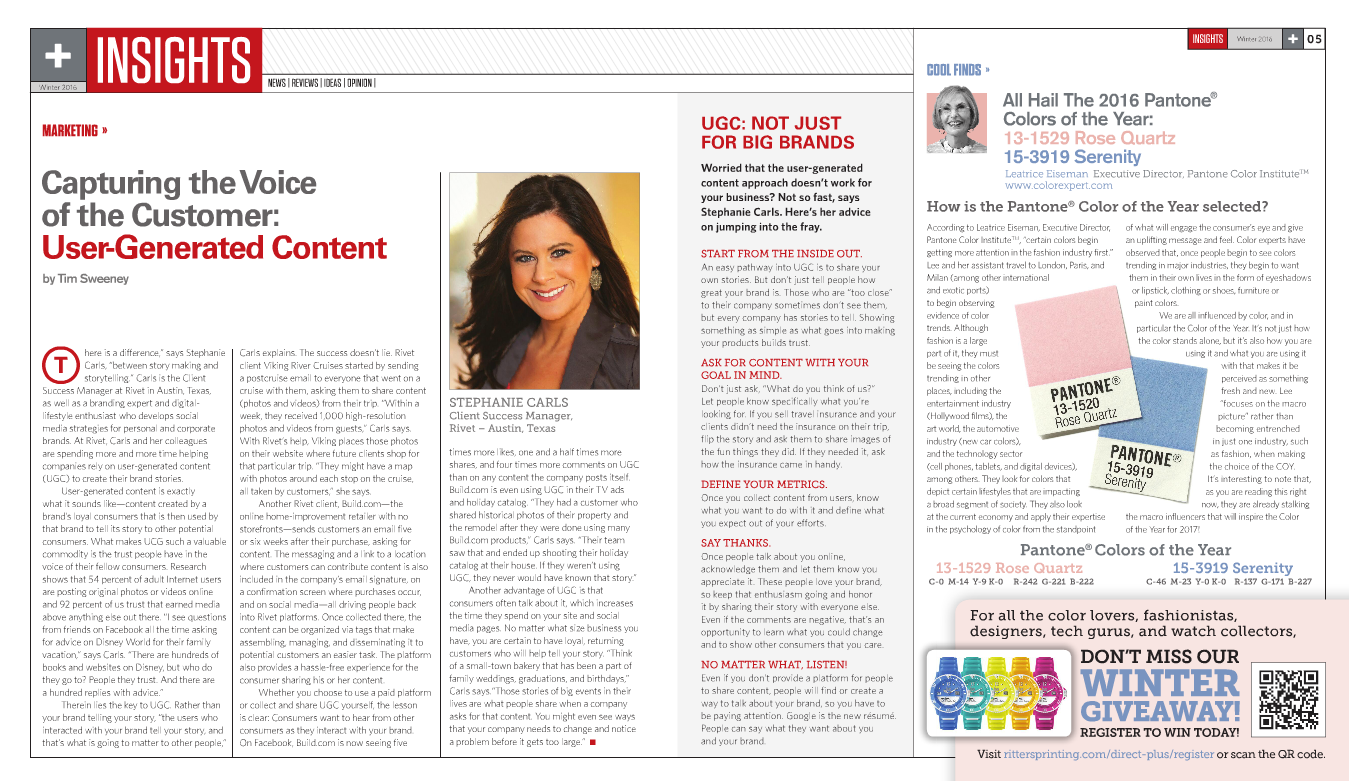Capturing the Voice of the Customer: User Generated Content
Article by Tim Sweeney - Produced for 6 printed publications via CMO Team
Building a strategy and roadmap to capture and use photos, videos, narratives, opinions and customer preferences
“There is a difference,” says Stephanie Carls, “between story making and storytelling.” Carls is the Client Success Manager at Rivet in Austin, Texas, as well as a branding expert and digital lifestyle enthusiast who develops social media strategies for personal and corporate brands. At Rivet, Carls and her colleagues are spending more and more time helping companies rely on User Generated Content (UGC) to create their brand stories.
User Generated Content is exactly what it sounds like—content created by a brand’s loyal consumers that is then used by that brand to tell its story to other potential consumers. What makes UCG such a valuable commodity is the trust people have in the voice of their fellow consumers. Research shows that 54 percent of adult internet users are posting original photos or videos online, and 92 percent of us trust that earned media above anything else out there. “I see questions from friends on Facebook all the time asking for advice on Disney World for their family vacation,” says Carls. “There are hundreds of books and websites on Disney, but who do they go to? People they trust. And there are a hundred replies with advice.”
Therein lies the key to UGC. Rather than your brand telling your story, “The users who interacted with your brand tell your story and that’s what is going to matter to other people,” Carls explains. The success doesn’t lie. Rivet client Viking River Cruises started by sending a post-cruise email to everyone that went on a cruise with them, asking them to share content (photos and videos) from their trip. “Within a week, they received 1,000 hi-res photos and videos from guests,” Carls says. With Rivet’s help, Viking places those photos on their website where future customers shop for that particular trip. “They might have a map with photos around each stop on the cruise, all taken by customers,” she says.
Another Rivet client, Build.com—the online home improvement retailer with no storefronts—sends customers an email five or six weeks after their purchase asking for content. The messaging and a link to a location where customers can contribute content is also included in the company’s email signature, on a confirmation screen where purchases occur, and on social media—all driving people back into Rivet platforms. Once collected there, the content can be organized via tags that make assembling, managing and disseminating it to potential customers an easier task. The platform also provides a hassle-free experience for the consumer sharing his or her content.
Whether you choose to use a paid platform or collect and share UGC yourself, the lesson is clear: consumers want to hear from other consumers as they interact with your brand. On Facebook, Build.com is now seeing five times more likes, one and a half times more shares, and four times more comments on UGC than on any content the company posts itself. Build.com is even using UGC in their TV ads and holiday catalog. “They had a customer who shared historical photos of their property and the remodel after they were done using many Build.com products,” Carls says. “Their team saw that and ended up shooting their holiday catalog at their house. If they weren’t using UGC, they never would have known that story.”
Another advantage of UGC is that consumers often talk about it, which increases the time they spend on your site and social media pages. No mater what size business you have, you are certain to have loyal, returning customers who will help tell your story. “Think of a small town bakery that has been a part of family weddings, graduations and birthdays,” Carls says. “Those stories of big events in their lives are what people share when a company asks for that content. You might even see ways that your company needs to change, and notice a problem before it gets too large.”
SIDEBAR:
UGC: NOT JUST FOR BIG BRANDS
Worried that the User Generated Content approach doesn’t work for your business? Not so fast, says Stephanie Carls. Here’s her advice on jumping into the fray.
Define your metrics—Once you collect content from users, know what you want to do with it and define what you expect out of your efforts.
Start from the inside out—An easy pathway into UGC is to share your own stories. But don’t just tell people how great your brand is. Those who are “too close” to their company sometimes don’t see them, but every company has stories to tell. Showing something as simple as what goes into making your products builds trust.
Ask for content with your goal in mind— Don’t just ask, “What do you think of us?” Let people know specifically what you’re looking for. If you sell travel insurance and your clients didn’t need the insurance on their trip, flip the story and ask them to share images of the fun things they did. If they needed it, ask how the insurance came in handy.
Say Thanks—Once people talk about you online, acknowledge them and let them know you appreciate it. These people love your brand so keep that enthusiasm going and honor it by sharing their story with everyone else. Even if the comments are negative, that’s an opportunity to learn what you could change and show other consumers that you care.
No matter what, listen!—Even if you don’t provide a platform for people to share content, remember that people will find or create a way to talk about your brand, so you have to be paying attention. Google is the new résumé. People can say what they want about you and your brand.

